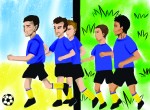Six months after he watched UCLA’s season come crashing to a halt with a 5-2 loss to San Diego in the second round of the NCAA tournament, men’s soccer assistant coach Eddie Soto stood on a beach in the Bahamas, his feet buried in the sand.
But this was no vacation. Soto was hard at work at his second job as coach of the U.S. Beach Soccer National Team.
At the CONCACAF Beach Soccer Championship, held in Nassau, Bahamas on May 12, Soto and the U.S. national team beat El Salvador 5-4 in overtime to win the tournament, earning a berth to the FIFA Beach Soccer World Cup. The World Cup will take place in Tahiti in September.
The U.S. national team has a distinct UCLA flavor to it beyond just Soto. Four UCLA soccer alumni – Mike Enfield, Jason Leopoldo, Ryan Futagaki and Kyle Nakazawa – are members of the team, a fact that Soto believes has contributed to the team’s success.
“It’s just an advantage because you know what they bring, you know they’re competitors, you know what makes them tick, you know how to get to them and how to get the most out of them,” Soto said.
But while all these Bruins had success in soccer at UCLA, getting accustomed to beach soccer has been a process.
“To be honest, it’s a completely different game. The first couple years I started playing it, it was difficult to get acclimated to it,” Leopoldo said.
The differences between playing on the sand as opposed to the pitch are extensive. The field dimensions shrink from approximately 115 by 74 yards to 30 by 40 yards on the beach, and the game is played with just five players for each team. These rule variances, along with the challenge of playing on sand, have forced Soto to alter his coaching philosophies and strategies.
“With the sand being so unpredictable, it’s more of an aerial game. You look to try to do more combinations in the air,” Soto said.
“It’s really dynamic in regards to how goals are scored with bicycle kicks and volleys. And being on such a small field, you get higher scoring in games and lots of action.”
With the smaller field, the goalkeeper is also forced to take on a more offensive role, another thing Soto adds to his strategy.
“Your goalkeeper is kind of like your quarterback because you’re able to roll the ball back to your goalkeeper and he can pick it up with his hands once per possession, and that’s different than regular soccer where goalkeepers can’t do that, so it’s important to have a goalkeeper who not only is a good shot protector, but can also be a distributor and get a lot of power in his throw,” Soto said.
The different playing environment poses physical challenges as well as strategic ones. Players have to rely even more heavily on the technical side of their game and have to use a completely different type of fitness from field soccer.
“There’s unlimited subs. You can go in and out kind of like hockey, but you’re sprinting up and down the sand for three minutes – it’s like playing 45 minutes of soccer on grass, so it’s a different fitness,” Nakazawa said.
As Soto helps his players make the transition to sand, he has to adjust his coaching mindset as well, making the switch from UCLA’s field soccer team to the different strategies of beach soccer.
“I don’t really consider myself a beach soccer coach because I don’t get to do it all the time. … My area of expertise is working on the grass and when I get together on the sand it’s a learning experience for me as well,” Soto said.
Soto’s learning process began in 1996, after he was cut from his MLS team, the New York MetroStars, and got a call to join a beach soccer team, where he played on and off for the next few years.
In 2001, he became a full-time assistant coach, starting at Cal State Fullerton before coming to UCLA in 2006.
After taking over as head coach for U.S. beach soccer several years ago, Soto is reconnecting with some former players, as Leopoldo and Nakazawa both played under him while at UCLA.
“I’ve always thought highly of Eddie. He’s always been a great coach, always been a good friend of mine,“ Nakazawa said.
“If I were to come back to play after professional, he’s the guy I’d want to play for and I actually got the opportunity to do that and it was awesome.”
Beyond playing for a former coach, the opportunity to play with fellow UCLA alumni has been one the former Bruins have embraced.
“It brings back great memories,” Leopoldo said. “It’s good to be back on the field playing with guys that I played with while I was in school and guys that came before me.”
But this team has more on its mind than just a reunion. It has its sights set on winning the World Cup.
“Personally, I’m thrilled. It’s cool, whether it’s outdoor football or beach soccer, to represent your country in the World Cup, so I’m extremely, extremely excited,” Soto said.
“And I’m really proud of our guys, because our guys put a lot of their time and energy into this and they’re going to be rewarded by being able to represent the United States in the World Cup.”
